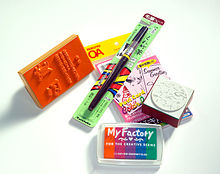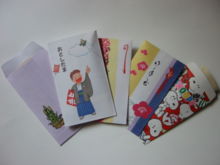- Japanese New Year
-
Japanese New Year 
The kadomatsu is a traditional decoration for the new year holiday.Official name Shōgatsu (正月) Observed by Japanese Type Cultural Significance Celebrates the new year Date 1 January Related to Chinese New Year, Vietnamese New Year, Korean New Year The Japanese New Year (正月 shōgatsu) is one of the most important annual festivals, with its own unique customs, and has been celebrated for centuries. Due to the importance of the holiday and the preparations required, the preceding days are quite busy, particularly the day before, known as Ōmisoka.
The Japanese New Year has been celebrated since 1873 according to the Gregorian calendar, on January 1 of each year (New Year's Day where the Gregorian calendar is used).
Contents
History
Prior to the Meiji Period, the date of the Japanese New Year was based on the Chinese lunar calendar, as are the contemporary Chinese, Korean, and Vietnamese New Years. However, in 1873, five years after the Meiji Restoration, Japan adopted the Gregorian calendar and the first day of January became the official and cultural New Year's Day.
Traditional food
Japanese people eat a special selection of dishes during the New Year celebration called osechi-ryōri (御節料理 or お節料理), typically shortened to osechi. This consists of boiled seaweed (昆布 konbu), fish cakes (蒲鉾 kamaboko), mashed sweet potato with chestnut (栗きんとん kurikinton), simmered burdock root (金平牛蒡 kinpira gobo), and sweetened black soybeans (黒豆 kuromame). Many of these dishes are sweet, sour, or dried, so they can keep without refrigeration—the culinary traditions date to a time before households had refrigerators, when most stores closed for the holidays. There are many variations of osechi, and some foods eaten in one region are not eaten in other places (or are considered unfortunate or even banned) on New Year's Day. Another popular dish is ozōni (お雑煮), a soup with omochi (お餅) and other ingredients that differ based on various regions of Japan. Today, sashimi and sushi are often eaten, as well as non-Japanese foods. To let the overworked stomach rest, seven-herb rice soup (七草粥 nanakusa-gayu) is prepared on the seventh day of January, a day known as jinjitsu (人日).
Bell ringing
At midnight on December 31, Buddhist temples all over Japan ring their bells a total of 108 times to symbolize the 108 human sins in Buddhist belief, and to get rid of the 108 worldly desires regarding sense and feeling in every Japanese citizen. A major attraction is The Watched Night bell, in Tokyo. Japanese believe that the ringing of bells can rid off their sins during the previous year. After they are done ringing the bells, they celebrate and feast on soba noodles.[citation needed]
Postcards
The end of December and the beginning of January are the busiest times for the Japanese post offices. The Japanese have a custom of sending New Year's Day postcards (年賀状 nengajō) to their friends and relatives, similar to the Western custom of sending Christmas cards. Their original purpose was to give your faraway friends and relatives tidings of yourself and your immediate family. In other words, this custom existed for people to tell others whom they did not often meet that they were alive and well.
Japanese people send these postcards so that they arrive on the 1st of January. The post office guarantees to deliver the greeting postcards on the first of January if they are posted within a time limit, from mid-December to near the end of the month and are marked with the word nengajō. To deliver these cards on time, the post office usually hires students part-time to help deliver the letters.
It is customary not to send these postcards when one has had a death in the family during the year. In this case, a family member sends a simple postcard called 喪中葉書 (mochyuu hagaki もちゅうはがき, eng: mourning postcards) to inform friends and relatives they should not send New Year's cards, out of respect for the deceased.
People get their nengajō from many sources. Stationers sell preprinted cards. Most of these have the Chinese zodiac sign of the New Year as their design, or conventional greetings, or both. The Chinese zodiac has a cycle of 12 years. Each year is represented by an animal. The animals are, in order: rat, ox, tiger, rabbit, dragon, snake, horse, sheep, monkey, rooster, dog, and boar. 2007 was the year of the boar, 2008 was the year of the rat, 2009 was the year of the ox, 2010 was the year of the tiger, and 2011 is the year of the rabbit and 2012 will be the year of the dragon. Famous characters like Snoopy, (2006) and other cartoon characters like Mickey and Minnie Mouse, (2008) have been especially popular in their celebrated years.
The postcards may have spaces for the sender to write a personal message. Blank cards are available, so people can hand-write or draw their own. Rubber stamps with conventional messages and with the annual animal are on sale at department stores and other outlets, and many people buy ink brushes for personal greetings. Special printing devices are popular, especially among people who practice crafts. Software also lets artists create their own designs and output them using their computer's color printer. Because a gregarious individual might have hundreds to write, print shops offer a wide variety of sample postcards with short messages so that the sender has only to write addresses. Even with the rise in popularity of email, the nengajō remains very popular in Japan.
Conventional nengajō greetings include:
- kotoshi mo yoroshiku o-negai-shimasu (今年もよろしくお願いします) (I hope for your favour again in the coming year)
- (shinnen) akemashite o-medetō-gozaimasu ((新年)あけましておめでとうございます) (Happiness to you on the dawn [of a New Year])
- kinga shinnen (謹賀新年) (Happy New Year)
- shoshun/hatsuharu (初春) (literally "early spring")
Otoshidama
Pouch for giving otoshidama called otoshidama-bukuro (お年玉袋?).
On New Year's Day, Japanese people have a custom of giving money to children. This is known as otoshidama (お年玉?). It is handed out in small decorated envelopes called 'pochibukuro,' similar to Goshugi bukuro or Chinese red envelopes and to the Scottish handsel. In the Edo period large stores and wealthy families gave out a small bag of mochi and a Mandarin orange to spread happiness all around. The amount of money given depends on the age of the child but is usually the same if there is more than one child so that no one feels slighted. It is not uncommon for amounts greater than 10,000¥($100) to be given.
Mochi
Another custom is creating rice cakes (餅 mochi). Boiled sticky rice (餅米 mochigome) is put into a wooden shallow bucket-like container and patted with water by one person while another person hits it with a large wooden mallet. Mashing the rice, it forms a sticky white dumpling. This is made before New Year's Day and eaten during the beginning of January.
Mochi is made into a New Year's decoration called kagami mochi (鏡餅), formed from two round cakes of mochi with a bitter orange (橙 daidai) placed on top. The name daidai is supposed to be auspicious since it means "several generations."
Because of mochi's extremely sticky texture, there is usually a small number of choking deaths around New Year in Japan, particularly amongst the elderly. The death toll is reported in newspapers in the days after New Year.[1]
Poetry
The New Year traditions are also a part of Japanese poetry, including haiku and renga. All of the traditions above would be appropriate to include in haiku as kigo (season words). There are also haiku that celebrate many of the "first" of the New Year, such as the "first sun" (hatsuhi) or "first sunrise", "first laughter" (waraizome—starting the New Year with a smile is considered a good sign), and first dream (hatsuyume). Since the traditional New Year was later in the year than the current date, many of these mention the beginning of spring.
Along with the New Year's Day postcard, haiku might mention "first letter" (hatsudayori—meaning the first exchange of letters), "first calligraphy" (kakizome), and "first brush" (fude hajime).
Games
It was also customary to play many New Year's games. These include hanetsuki, takoage (kite flying), koma[disambiguation needed
 ] (top), sugoroku, fukuwarai (whereby a blindfolded person places paper parts of a face, such as eyes, eyebrows, a nose and a mouth, on a paper face), and karuta.
] (top), sugoroku, fukuwarai (whereby a blindfolded person places paper parts of a face, such as eyes, eyebrows, a nose and a mouth, on a paper face), and karuta.Entertainment
There are many shows created as the end-of-year, and beginning-of-year entertainment, and some being a special edition of the regular shows. For many decades, it has been customary to watch the TV show Kōhaku Uta Gassen aired on NHK on New Year's Eve. The show features two teams, red and white, of popular music artists competing against each other.
Beethoven's Ninth
Beethoven's Ninth Symphony, with accompanying chorus, is traditionally performed throughout Japan during the New Years season. In December 2009, for example, there were 55 performances of the symphony by various major orchestras and choirs in Japan.[2]
The Ninth was introduced to Japan by German prisoners-of-war held in Japan during World War I. Japanese orchestras, notably the NHK Symphony Orchestra, began performing the symphony in 1925. During World War II, the Imperial government promoted performances of the symphony, including on New Year's Eve, to encourage allegiance to Japanese nationalism. The symphony was considered appropriate in this regard because Nazi Germany was an ally of Japan. After the war, orchestras and choruses, undergoing economic hard times during the reconstruction of Japan, promoted performances of the piece around New Years because of the popularity of the music with the public. In the 1960s, performances of the symphony at New Years became more widespread, including participation by local choirs and orchestras, and established the tradition which continues to this day.[3]
Hatsumōde, hatsuhinode, the "firsts" of the year
Celebrating the new year in Japan also means paying special attention to the first time something is done in the new year.
Hatsuhinode (初日の出) is the first sunrise of the year. Before sunrise on January 1, people often drive to the coast or climb a mountain so that they can see the first sunrise of the new year.
Hatsumōde is the first trip to a shrine or temple. Many people visit a shrine after midnight on December 31 or sometime during the day on January 1. If the weather is good, people often dress up or wear kimono.
In addition to the other firsts mentioned above ("first sun" (hatsuhi) or "first sunrise", "first laughter" (waraizome—starting the New Year with a smile is considered a good sign), first dream (初夢, hatsuyume), and "first letter" (hatsudayori—meaning the first exchange of letters) – in addition to haiku-specific ones), other "firsts" that are marked as special events include shigoto-hajime (仕事始め, the first work of the new year), keiko-hajime (稽古始め, the first practice of the new year), hatsugama (the first tea ceremony of the new year), and the hatsu-uri (the first shopping sale of the new year).
References
- ^ http://search.japantimes.co.jp/cgi-bin/nn20070103a6.html
- ^ Brasor, Philip, "Japan makes Beethoven's Ninth No. 1 for the holidays", Japan Times, 24 December 2010, p. 20, retrieved on 24 December 2010; Uranaka, Taiga, "Beethoven concert to fete students' wartime sendoff", Japan Times, 1 December 1999, retrieved on 24 December 2010.
- ^ Brasor, Philip, "Japan makes Beethoven's Ninth No. 1 for the holidays", Japan Times, 24 December 2010, p. 20, retrieved on 24 December 2010.
See also
- Customs and etiquette of Japan
- Japanese festivals
- Japanese calendar
- Japanese cuisine
- New Year
- Toso Spiced medicinal sake
Categories:- Festivals in Japan
- New Year celebrations
- Public holidays in Japan
- January observances
- Postcards
- Buddhist holidays
Wikimedia Foundation. 2010.


